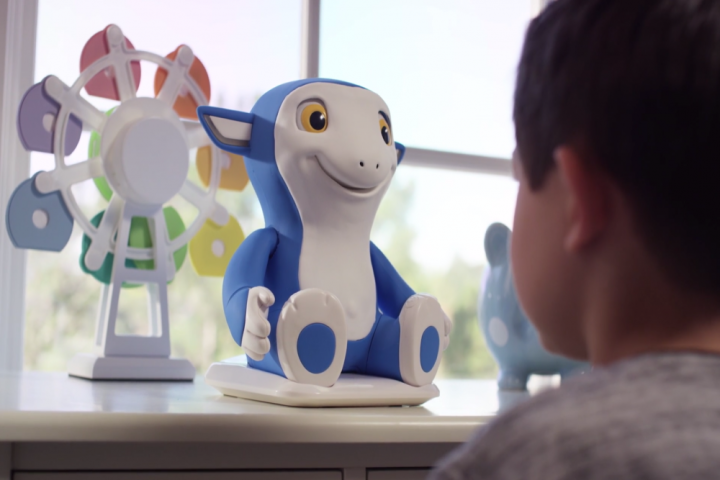
Patrick Chiang, a former Jawbone executive and CEO of Empath Interactive, spent two years building a safer alternative. The result — Elfkins — is a cuddly, internet-connected toy that transmits voice messages from kids to loved ones, and vice versa.
The motorized Elfkin can wave its arms up and down, blink its eyes, move its mouth, and lean forward and backward. Multicolor LEDs embedded in its ears glow blue to indicate a new message has arrived, and built-in buttons on the Elfkins’s feet trigger a tutorial, adjust the volume level, and cycle between messaging contacts.
“It’s built for the way kids interact,” Chiang said. “It captures their imagination.”

Elfkins messaging, which can be set up in less than five minutes, is a lot more engaging and intuitive than traditional social networks, Chiang said. He sees it as an alternative to video chat apps, which he said can be difficult for kids to use.
“When I’d travel for business, I’d set up an iPhone on a stand and show my daughter how to record messages,” he said. Most were out of focus, or showed the floor or ceiling. “Kids don’t want to stay on camera,” Chiang said. “Sometimes getting a video is way worse than just the audio. Your mind fills in the gaps.”
Each Elfkin pairs with a smartphone app that parents, relatives, and other loved ones can use to remotely manage the toy robot. The app’s mostly for messaging — parents can record greetings themselves, or recruit any family members and friends they’ve invited into a “trusted circle” to send messages of their own.
Once senders record a message, they can assign a “beginning” animation and an “ending” animation to it — Chiang said the team consulted a former Pixar animator on the Elfkins’ 11 different animated expressions. Elfkins can laugh, celebrate, blow a kiss, yawn, and wave goodnight. “We’re conscious about the animations,” he said. “We want to avoid the uncanny valley.”

After a message has been recorded and choreographed, it can be sent to the Elfkin immediately, or scheduled for a future date. “If your child has a dance recital, you can set the delivery time for when that would be,” Chiang said. “You can send them words of encouragement an hour before it begins.”
The app’s more than just a messaging platform, though. Chiang sees it as a place for close groups and family to circulate family photos, messages, and other personal items among each other — a private, shareable repository for “the big and little moments” in a child’s life. Members in the Elfkin app’s “trusted circle” can share and comment on pictures, post messages, and favorite content that other members have published. “It’s effectively like what you’d see in a standard social network,” he said.
Kids have a much more scripted Elfkins experience. They can select a message recipient from a predetermined list, and send a message by touching the microphone button on the toy’s foot. And they complete “Elfkins activities” — templates crafted by children’s authors that entertain and educate.
The Elfkins team doubled down on simplicity, Chiang said. They decided against voice recognition because of “young kids’ tendency to mispronounce things,” Chiang said. And they ditched the touch-sensitive approach of earlier prototypes to minimize accidental triggers. “We didn’t want to over-engineer a solution to a problem that didn’t exist,” he said.
Chiang’s team made privacy a focus, too. Users who haven’t received an invite from Elfkins admins — parents, in most cases — can’t see photos or messages. All conversations are encrypted, and deleted after four weeks. And Elfkins toys only store the last recorded message.

“We’ve done everything within our power to make it as secure as possible,” Chiang said. “We’ve made it so that it’s really secure.”
Chiang conceded that voice-activated toys are a competitive category, but said that Elfkins is designed to last. “It’ll get better over time,” he said. “It won’t get old.”
Elfkins, which counts former Napster CEO Sean Parker among its investors, will retail for $150 when it goes on sale later this year. Deliveries are expected to begin in August.


